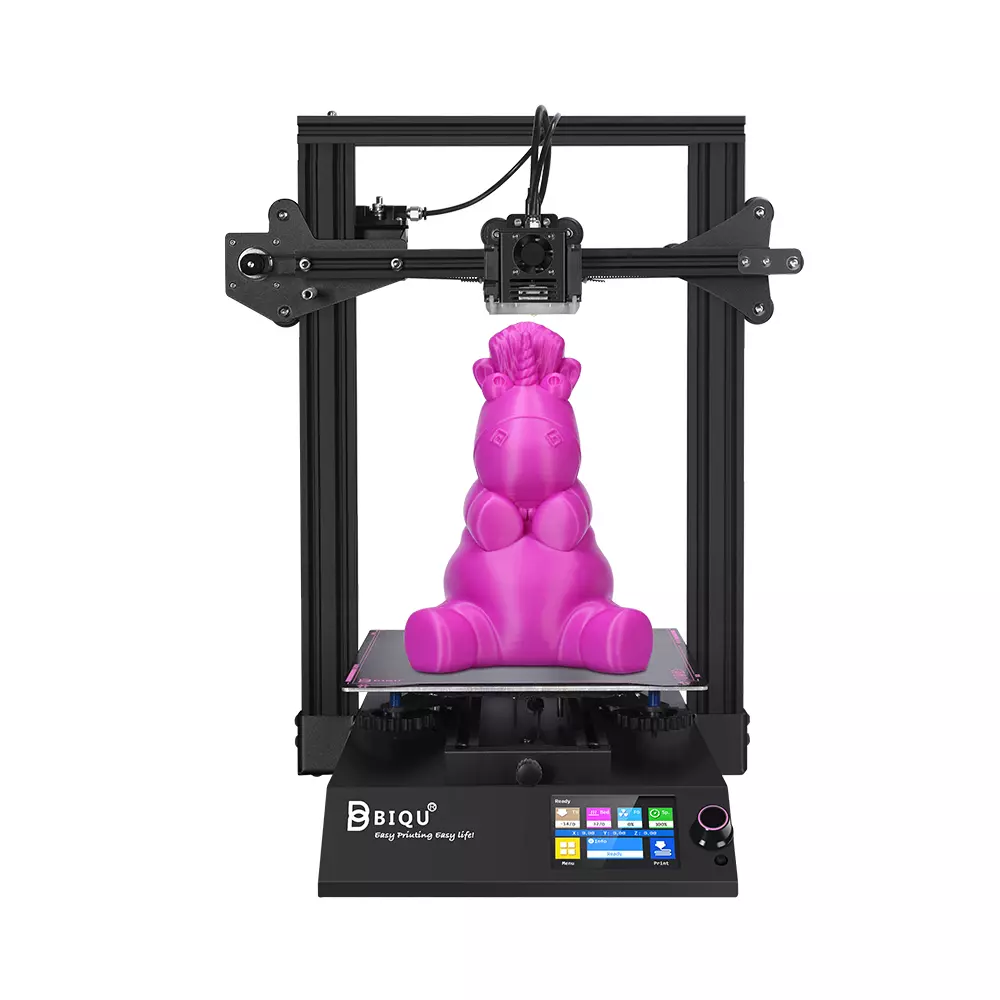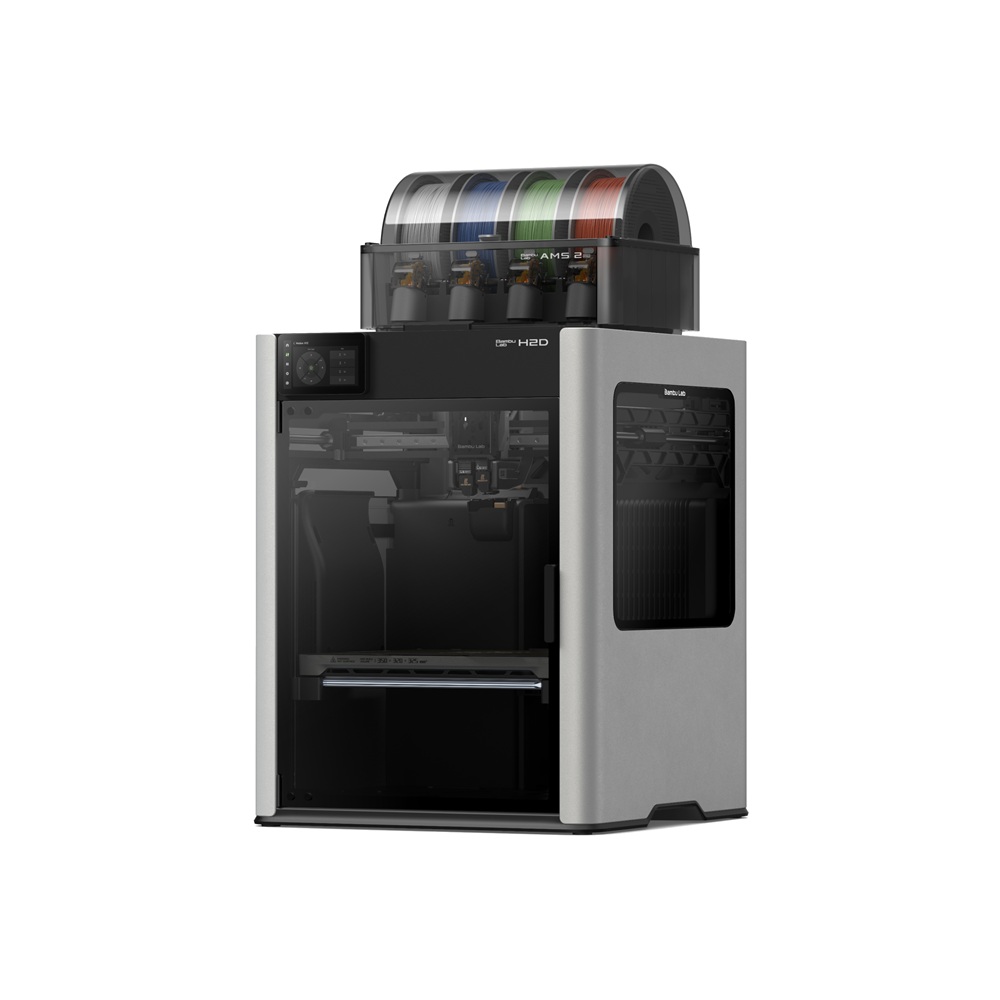Compare BIQU B1 vs H2D
Comparison between the best 3D printers
Choose the best 3D printer at the best price. The cheapest 3D printers are here.
Buy a 3D printer here with 3D Fila.
 |
 |
|
| Model | BIQU B1 |
H2D |
| Printing Material | Filament | Filament |
| Buy Filament for BigTreeTech BIQU B1 | Buy Filament forBambu Lab H2D | |
| Estimated price | $269,00 | $1899,00 |
| Manufacturer | BigTreeTech | Bambu Lab |
| Release Year | 2020 | 2025 |
| Print Volume [mm] | 235x235x270 | 350x320x325 |
| Printer Size [mm] | 412x402x492 | 492x514x626 |
| Weight [kg] | 8,00 | 42,3 |
| Power Loss Recovery | YES | YES |
| Enclosed printer | NO | YES |
| Bed Leveling | Manual | Automatic |
| Filament End Sensor | YES | YES |
| Bed type | Heated | Heated |
| Power supply system | Bowden | Direct Drive |
| Standard nozzle | 0,4 | 0,4 |
| Maximum Nozzle Temperature [°C] | 250 | 350 |
| Maximum Bed Temperature [°C] | 100 | 120 |
| Maximum printing speed [mm/s] | 100 | 600 |
| Filament holder | YES | YES |
| Camera for supervision | NO | NO |
| Recommended filaments | PLA, TPU, ABS, PETG | PLA, PETG, ABS, ASA, TPU, PVA, Nylon (PA) |
| Recommended slicers | Cura, Simplify, Slic3r | Bambu Studio |
| Maximum Resolution [mm] | 0,1 | 0,01 |
| Processor | 32 Bits BTT SKR V 1.4 | |
| Display | Touchscreen TFT 3,5'' | Touchscreen 5'' |
| Power Supply | 24V / 360W | |
| Connectivity | SD / USB | Wifi, Bambu bus, Cartão SD |
| Operating systems | Windows, Mac, Linux | Windows, Mac, Linux |
| Date of registration in the system | 2021-04-14 | 2025-03-31 |
| Release date | 2020 | 2025 |
| Extra features | The BIQU B1 is an advanced 3D printer with a silent 32-bit BTT SKR V1.4 motherboard and ARM Cortex-M3 CPU, offering DIY interfaces (I2C, SPI, WiFi) and dual Z-axis. Its dual BTT B1 TFT35 V3.0 operating system allows real-time monitoring and multiple printing modes, including G-code visualization effects. It stands out for its BIQU SSS (Super Spring Steel), ensuring easy model adhesion and simplified removal, with the possibility of using it on both sides. It includes a filament sensor, automatically pausing printing in case of filament breakage. The multicolored RGB lights integrated into the hotend allow you to view the printing status even at night. Additional notes include the need for a BIQU-specific Type-C cable and extra interfaces for smart filament sensor and BL Touch. | Bambu Labs H2D combines high-speed 3D printing with a chamber heated up to 65 °C, dual extrusion with automatic nozzle switching, an AMS for filament drying and exchange, and AI sensors that detect failures. It offers optional laser and digital cutting capabilities, features intelligent calibration through computer vision, vibration control, enhanced fire safety, and real-time camera monitoring. |
| Support for multiple colors and materials (AMS and CFS) | NO | YES |
Notes * |
||
| Cost-benefit | 7 / 10 | 7 / 10 |
| Hardware | 2 / 10 | 7.2 / 10 |
| Tela | . | . |
| Print volume | 3 / 10 | 4 / 10 |
| Performance | 1 / 10 | 5 / 10 |
Conclusion |
| In comparing the BIQU B1 and Bambu Lab H2D, it's evident that both printers serve different needs within the 3D printing community, reflecting a clear distinction in capabilities and intended users. The BIQU B1 stands out as a cost-effective option, ideal for hobbyists and those entering the 3D printing space. Its manual bed leveling and smaller print volume may deter advanced users, but its affordable price, simple operation, and decent build quality make it a solid choice for beginners. The BIQU B1 also supports a range of filaments and has commendable features such as power loss recovery and filament detection, allowing for more reliable printing. Conversely, the Bambu Lab H2D is a premium option that caters to professionals and serious enthusiasts. With its automatic bed leveling, larger print volume, and advanced features like dual extrusion and intelligent calibration, it provides a robust platform for complex projects. The high printing speed and enhanced material versatility of the H2D further justify its higher price point, making it suitable for those who intend to produce high-quality, intricate designs quickly. In summary, the BIQU B1 offers great value for its price and is ideal for entry-level users, while the Bambu Lab H2D represents a significant investment aimed at delivering superior performance, advanced capabilities, and professional quality prints for those willing to invest more. The choice ultimately depends on the user’s specific needs, budget constraints, and printing ambitions. |

